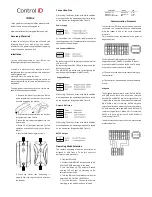
iDProx
Thank you for purchasing the iDProx proximity card
reader! Check out our online guide at:
www.controlid.com.br/userguide/idprox-en.pdf
Necessary Materials
In order to install your iDProx, you will need the
following items: drill, wall plugs and screws,
screwdriver, 12V power supply capable of supplying
at least 1A and an electronic lock.
Installation
For the correct operation of your iDProx, the
following precautions should be taken:
• Install in a place that is not exposed to direct
sunlight and that is protected from rain and other
natural phenomena
• Install iDProx 1,5m above the floor.
• Before securing the equipment in place, ensure all
connecting cables are correctly routed towards the
equipment.
The equipment installation process is simple and
should follow the sequence below:
1. Remove the plastic lens from the iDProx
with a screwdriver that is at least 3 mm wide
(to avoid damaging the plastic):
2. Use the reference pattern on the back of
this guide to drill the 2 holes
3. Insert the wall plugs completely into the
holes made
4. Route all of the cables required for the
operation and connect them to the iDProx
cables
5. Secure the iDProx using two screws
6. Place the plastic lens positioning it
properly and securing the top first and then
the bottom
Connection Pins
⚠
Warning: The Green, Green with White and Blue
wires depend on the operating mode that is set up
on the equipment (Wiegand or ABA Track II).
Power Supply
⚠
Connection to a +12V power supply capable of
supplying at least 1A is fundamental for the correct
operation of the equipment
Led Control and Buzzer
By connecting the LED-IN pin to ground, the internal
LED turns red.
By connecting the MODE / BZ pin to the ground, the
buzzer is activated.
The MODE / BZ pin is also used for configuring the
operating mode (Wiegand or ABA Track II)
Wiegand Output
⚠
Warning: The Green, Green with White and Blue
wires depend on the operating mode that is set up
on the equipment (Wiegand or ABA Track II).
Output ABA Track II
⚠
Warning: The Green, Green with White and Blue
wires depend on the operating mode that is set up
on the equipment (Wiegand or ABA Track II).
RS232 Output
Operating Mode Selection
The reader's operating mode can be selected as
Wiegand or ABA Track II. To do this, you must
perform a simple procedure:
1. Turn the iDProx off
2. Connect the MODE / BZ (Yellow) cable to D0,
D1 or CARDPRES according to the table.
3. Turn the iDProx on. The buzzer will sound
and the LED will light up according to the
selected configuration.
4. Turn the iDProx off and reconnect all cables
normally: D0, D1, MODE / BUZZER etc.
5. Turn the iDProx on. The device will work
according to the mode previously selected.
Connection
Mode
LED
MODE/BZ + D0
Wiegand 26
Green
MODE/BZ + D1
Wiegand 34
Yellow
MODE/BZ + CARDPRES
ABA
Red
Communication Protocols
In order for the iDProx to work properly, it must be
connected to a controller that can communicate
with the reader in one of the three supported
protocols.
This controller will be represented in this guide as
depicted below:
The WIN1 and WIN0 inputs are used for the
Wiegand protocol; CARDP, CLK and DATA inputs
are used for ABA Track II and the RX and TX inputs
are used for communication via RS232.
⚠
The names of the inputs may vary according to
the controller.
⚠
The controller inputs depend on the model and
brand.
Wiegand
The Wiegand protocol uses 3 wires: DATA0, DATA1
and GND. When there is no data to be received,
both DATA0 and DATA1 remain in logical level 1, ie.
it is possible to measure 5V between the cables and
GND. When a 0 bit is received, DATA0 will go to
logical level 0 (which means that you can measure
0V between this cable and GND) and DATA1 will
remain at logical level 1. When a bit 1 is received,
DATA1 will go to logical level 0 and DATA0 will
remain at logic level 1.
The necessary connections to use this protocol are
presented below:


